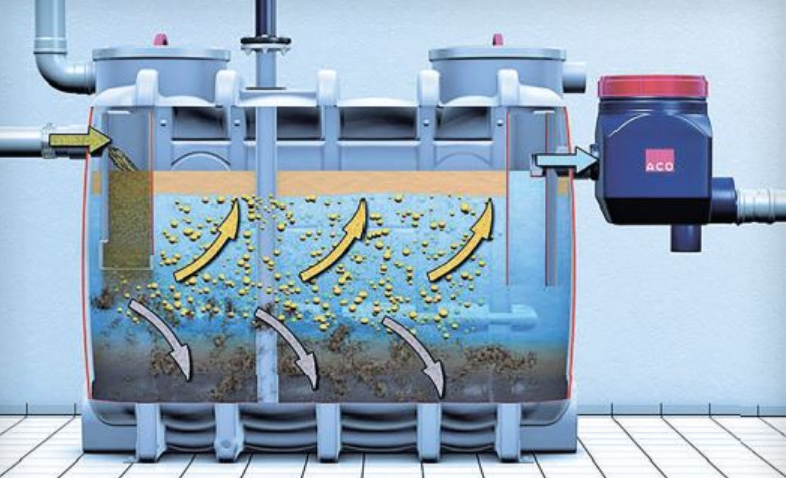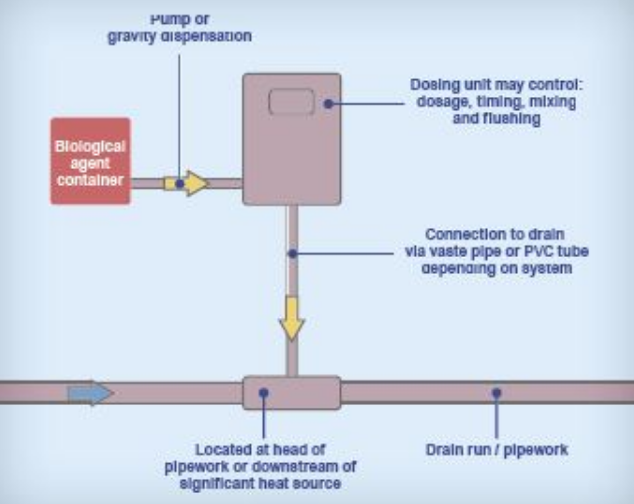Grease management

|
| ACO Gravity Grease Separator (ACO, 2017) |
Dealing with the problems of FOGs (Fats, Oils and Greases) entering our sewer system and measures that can be implemented to change the UK dosing systems to removal systems.
Contents |
[edit] Introduction
The UK experiences 366,000 sewer blockages every year flooding more than 3,000 properties through the accumulation of Fats, Oils and Greases (abbreviated to FOGs), all originating from domestic, commercial or industrial premises (Water UK 2017). This in turn costs the UK approximately £15 million to clear; financed mainly by the utility companies. These costs are then passed on to the consumer in the form of higher bills (CIBSE 2014). Clearly this is a problem that needs to be addressed.
[edit] UK Legislation unable to tackle the problem
The very vague and ineffectual UK regulations and legislation must bear much responsibility. Approved Document H offers little relief in its content stating; “…drainage serving kitchens in commercial hot food premises should be fitted with a grease separator complying with BS EN 1825-1 and designed in accordance with BS EN 1825-2 or other effective means of grease removal”. This has simply encouraged contractors to install dosage systems to push the problem downstream and push the cost on to the utility companies.
[edit] The Solutions: Dosage Versus Grease Separation

|
| Dosing System Components (British Water, 2017) |
One example of a dosage system is shown in the illustration above. It is the preferred method amongst UK contractors and retailers as it is easy to install and retrofit, space is saved and it is the cheapest option to implement. However, as waste water moves down the sewer network, FOGs can still regroup and impede waterflow.
More effective are the grease separation systems exemplified by the ACO Grease Separator (ACO, 2017). FOGs and wastewater are separated within a chamber and the water is cooled sufficiently to allow the FOGs to harden and the wastewater to be pumped away down the discharge sewer pipes devoid of any hardened FOGs. Clearly this is a much more effective system. With an improvement in UK legislation, updated building regulations, establishment of FOG concentrate levels and better enforcement, the £15 million cost of managing FOGs will be reduced significantly.
[edit] FOG Treatment Abroad
Clearly the occurrence of FOG blockages has been recognised as a major issue and other countries have been far more proactive in tackling the problem. Canada, Germany and the US have all implemented FOG concentrate limits of between 100 and 300 mg per litre of wastewater (Growdon 2017). These are then regularly sampled and inspected and when limits exceed these, heavy fines are levied on the offending outlet company.
As a result their sewer systems are much clearer.
This article was written by Luke Clapp (Hoare Lea), Tomasz Rosinski (Hoare Lea) and Joshua Gallagher (WSP). It was originally published by BSRIA in December 2018 at: https://www.bsria.co.uk/news/article/grease-management-treatment-or-removal/
--BSRIA
[edit] Related articles on Designing Buildings Wiki
- BSRIA articles on Designing Buildings Wiki.
- BSRIA.
- Clarified water.
- Drainage.
- Maintenance of drainage systems to prevent flooding and water pollution.
- Pipework.
- Public sewer.
- Safe ductwork - Loss Prevention Standard (LPS 2084).
- Safe working in drains and sewers.
- Sewer construction.
- Sewerage.
- Sustainable urban drainage systems SUDS.
- Water transfers and interconnections.
Featured articles and news
Infrastructure that connect the physical and digital domains.
Harnessing robotics and AI in challenging environments
The key to nuclear decommissioning and fusion engineering.
BSRIA announces Lisa Ashworth as new CEO
Tasked with furthering BSRIA’s impressive growth ambitions.
Public buildings get half a million energy efficiency boost
£557 million to switch to cleaner heating and save on energy.
CIOB launches pre-election manifesto
Outlining potential future policies for the next government.
Grenfell Tower Inquiry announcement
Phase 2 hearings come to a close and the final report due in September.
Progress from Parts L, F and O: A whitepaper, one year on.
A replicated study to understand the opinion of practitioners.
ECA announces new president 2024
Electrical engineer and business leader Stuart Smith.
A distinct type of countryside that should be celebrated.
Should Part O be extended to existing buildings?
EAC brands heatwave adaptation a missed opportunity.
Definition of Statutory in workplace and facilities management
Established by IWFM, BESA, CIBSE and BSRIA.
Tackling the transition from traditional heating systems
59% lack the necessary information and confidence to switch.
The general election and the construction industry
As PM, Rishi Sunak announces July 4 date for an election.
Eco apprenticeships continue help grow green workforce
A year after being recognised at the King's coronation.
Permitted development rights for agricultural buildings
The changes coming into effect as of May 21, 2024.






















